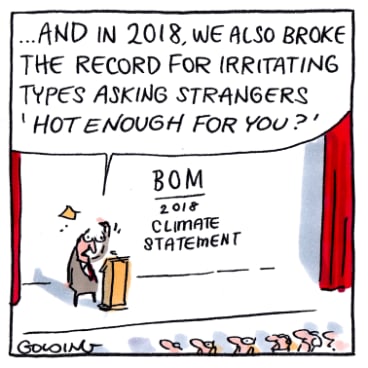The stunning chart revealing Australia's record-breaking run of rising temperatures

10 January, 2019
If there was any question Australians are enduring a more extreme, topsy-turvy climate, look only to the month just gone.
In early December, Cyclone Owen unloaded 678 millimetres of rain in one day on the tiny North Queensland town of Halifax. It was a new December daily rainfall record.
By mid-December, a month's worth of rain fell in parts of Victoria in 24 hours. On December 20 it was Sydney’s turn when a monster thunderstorm dropped giant hail stones – some the size of cricket balls. The insurance bill is nearing $675 million.
Then, the sun came out. By month’s end, much of Australia was baking under torrid temperatures. Marble Bar in Western Australia reached 49.3 degrees – the third-highest December temperature recorded anywhere in the country.
The record-breaking events are outlined in the Bureau of Meteorology’s 2018 climate statement released on Thursday, which confirmed the nation experienced its third-warmest year on record in 2018. The bureau attributed the year of meteorological extremes to both climate change and natural variability.
The national mean temperature in 2018 was 1.14 degrees above average. Nine of the 10 warmest years on record have occurred since 2005.
The bureau’s senior climatologist Lynette Bettio said every state and territory experienced above-average day and night temperatures last year.
“The average maximum temperature for the country as a whole was particularly warm, sitting 1.55 degrees above the 1961-1990 average, making 2018 Australia's second warmest year on record for daily high temperatures,” Dr Bettio said.
Australia's September rainfall was the lowest on record. Nationally, rainfall in 2018 was the lowest since 2005 and 11 per cent below average, while rainfall in some areas was significantly further below normal.
“Large areas of southeastern Australia experienced rainfall totals in the lowest 10 per cent on record, which exacerbated the severe drought conditions,” Dr Bettio said.

“NSW had its sixth driest year on record, while the Murray-Darling Basin saw its seventh-driest year on record.
"We did see some respite in the final three months of the year with decent rainfall in the east of the country.”
In other significant weather events last year, Broome broke its annual rainfall record just two months into the year and Tropical Cyclone Marcus was the strongest to affect Darwin since Tracy in 1974.
In August and September, up to 100 bushfires were active across NSW, Queensland and Victoria when warm, dry conditions brought an early start to the bushfire season.

The bureau said Australia was strongly influenced by both natural variability and climate change in 2018. Natural drivers included sea surface temperatures in the southern Tasman Sea which rose to “exceptionally high levels” in late 2017 and early 2018, contributing to warm overland conditions.
The report said Australia's climate “is increasingly influenced by global warming” and the nation has warmed by just over one degree since 1910. Most warming has occurred since 1950.
“The background warming trend can only be explained by human influence on the global climate,” the bureau said.

The Morrison government has been riven with internal tensions over climate change policy. Under the Paris climate accord, Australia has vowed to reduce greenhouse emissions, based on 2005 levels, by 26 per cent before 2030.
The government says Australia will meet that target "in a canter” however this claim has been contradicted by international bodies and the government’s own data.

Most recently, figures released by the Department of Environment and Energy last month showed that on current trends Australia will reduce emissions by just 7 per cent on 2005 levels by 2030, a massive 19 percentage points or two-thirds of the way short of the Paris agreement.
A major report prepared by the United Nations body for climate change, the Intergovernmental Panel on Climate Change, in October said coal-generated electricity must be phased out globally by 2050 if the world is to avoid the most catastrophic impacts of global warming, including the total destruction of the Great Barrier Reef.
It said radical, swift efforts must be taken to curb greenhouse gas pollution and keep the global temperature increase below the critical 1.5 degree threshold.
No comments:
Post a Comment
Note: only a member of this blog may post a comment.